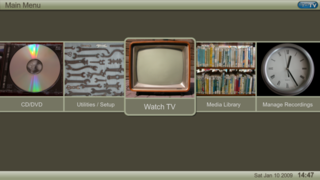This is a comparison of USB TV tuner sticks.
This is a comparison of USB TV tuner sticks.
This is a comparison of devices supporting the DVB-T2 standard.
| Name | Manufacturer | Year introduced | DVB standards support | Included antenna type | USB | Number of tuners | Encrypted programs support | Notes |
|---|---|---|---|---|---|---|---|---|
| DVB-T210 | August | circa 2012 | DVB-T/DVB-T2 | Mini | ||||
| DVB-T202 | August | circa 2011 | DVB-T/DVB-T2 | |||||
| DVB-T230 | August | circa 2011 | DVB-T/DVB-T2 | Mini | ||||
| MyGica DVB-T2 (T230) | Geniatech | circa 2016 | DVB-T/DVB-T2 | |||||
| EyeTV T2 | EyeTV - Geniatech | circa 2012 | ||||||
| EyeTV T2 lite | EyeTV - Geniatech | circa 2016 | Rod antenna | No | ||||
| TD310 | AverMedia | circa 2015 | DVB-T, DVB-T2, DVB-C | USB 2.0 / 3.0 | 1 | |||
| AVerTV Hybrid Volar T2 | AverMedia | circa 2015 | DVB-T, DVB-T2, DVB-C | USB 2.0 / 3.0 | 1 | |||
| WinTV-soloHD | Hauppauge | circa 2015 | DVB-T, DVB-T2, DVB-C | USB 2.0 / 3.0 | 1 | |||
| WinTV-dualHD | Hauppauge | DVB-T, DVB-T2, DVB-C | USB 2.0 / 3.0 | 2 | ||||
| CINERGY TC 2 Stick | TerraTec | circa 2016 | DVB-T, DVB-T2, DVB-C | USB 2.0 / 3.0 | 1 |
Video4Linux is a collection of device drivers and an API for supporting realtime video capture on Linux systems. It supports many USB webcams, TV tuners, and related devices, standardizing their output, so programmers can easily add video support to their applications.

A TV tuner card is a kind of television tuner that allows television signals to be received by a computer. Most TV tuners also function as video capture cards, allowing them to record television programs onto a hard disk much like the digital video recorder (DVR) does.

MythTV is a free and open-source home entertainment application with a simplified "10-foot user interface" design for the living room TV. It turns a computer with the necessary hardware into a network streaming digital video recorder, a digital multimedia home entertainment system, or home theater personal computer. It can be considered a free and open-source alternative to TiVo or Windows Media Center. It runs on various operating systems, primarily Linux, macOS, and FreeBSD.

A tuner is a subsystem that receives radio frequency (RF) transmissions, such as FM broadcasting, and converts the selected carrier frequency and its associated bandwidth into a fixed frequency that is suitable for further processing, usually because a lower frequency is used on the output. Broadcast FM/AM transmissions usually feed this intermediate frequency (IF) directly into a demodulator that converts the radio signal into audio-frequency signals that can be fed into an amplifier to drive a loudspeaker.

Hauppauge Computer Works is a US manufacturer and marketer of electronic video hardware for personal computers. Although it is most widely known for its WinTV line of TV tuner cards for PCs, Hauppauge also produces personal video recorders, digital video editors, digital media players, hybrid video recorders and digital television products for both Windows and Mac. The company is named after the hamlet of Hauppauge, New York, in which it is based.

MediaPortal is an open-source media player and digital video recorder software project, often considered an alternative to Windows Media Center. It provides a 10-foot user interface for performing typical PVR/TiVo functionality, including playing, pausing, and recording live TV; playing DVDs, videos, and music; viewing pictures; and other functions. Plugins allow it to perform additional tasks, such as watching online video, listening to music from online services such as Last.fm, and launching other applications such as games. It interfaces with the hardware commonly found in HTPCs, such as TV tuners, infrared receivers, and LCD displays.

Dreambox is a series of Linux-powered DVB satellite, terrestrial and cable digital television receivers, produced by German multimedia vendor Dream Multimedia.
The Broadcast Driver Architecture (BDA) is a Microsoft standard for digital video capture on Microsoft Windows operating systems. It encompasses the ATSC and DVB standards and gives developers a standardized method of accessing TV tuner devices. It is the driver component of Microsoft TV Technologies, and is used by hardware vendors to create digital TV tuning devices for Windows, and also to support new network types or custom hardware functionality. BDA is documented in the Windows DDK and the Platform SDK. Ideally, any BDA-compliant software should be compatible with any BDA-compliant hardware.

EyeTV is a European brand of TV tuners that allow users to watch TV on various devices including computers and smartphones. The brand was introduced in 2002 by Elgato Systems and was sold to Geniatech in 2016.
This is a comparison of digital video recorder (DVR), also known as personal video recorder (PVR), software packages. Note: this is may be considered a comparison of DVB software, not all listed packages have recording capabilities.

GB-PVR was a PVR application, running on Microsoft Windows, whose main function was scheduling TV recordings and playing back live TV. GB-PVR is no longer under active development and has been superseded by NextPVR, also known as nPVR.

A free-to-air or FTA Receiver is a satellite television receiver designed to receive unencrypted broadcasts. Modern decoders are typically compliant with the MPEG-2/DVB-S and more recently the MPEG-4/DVB-S2 standard for digital television, while older FTA receivers relied on analog satellite transmissions which have declined rapidly in recent years.
The Vu+, is a series of Linux-powered DVB satellite, terrestrial digital television receivers, produced by Korean multimedia brand Ceru Co., Ltd.
Unibox is a satellite, cable and terrestrial digital receiver. It has been distributed widely for use with Pay TV. It also enables the receiver to store digital copies of MPEG TS on internal harddisk or networked filesystems.

DVBViewer is proprietary, commercial software for viewing & recording of DVB TV & Radio using a TV tuner card or box and a Media Center for viewing Music, Video and Pictures. Among its other features are an Electronic Program Guide (EPG), remote control support, on-screen display, teletext, time shifting and picture-in-picture. Besides the support for BDA adapters, there is also the ability to use the Hauppauge MediaMVP with DVBViewer. The software also allows Unicable, DiSEqC and usage of CI-Modules with most adapters. The worldwide charge for the application is 15 euro or 22 US Dollars. Additional functions such as video on demand, TV series and movie management, home network distribution of TV to network devices including iPod Touch, iPhone & iPad & Android devices, and a recording service with web interface are provided by free plugins. A plug-in offering MHEG-5 and HbbTV support is available for a license fee of 12 euros.
A TV gateway is a television headend to a network UPnP router that receives live digital video broadcast (DVB) MPEG transport streams (channels) from terrestrial aerials, satellite dishes, or cable feeds and converts them into IP streams for distribution over an IP network.
VBox Home TV gateway is a network-enabled live TV tuner and PVR HDTV set-top-box produced by VBox Communications Ltd.
DVB Dream is a proprietary software for watching & recording of digital TV & radio with help of a digital TV tuner card. It supports the standards DVB-S (satellite), DVB-C (cable), DVB-T (terrestrial), ISDB-T, ISDB-S and ATSC.
TVHeadend, sometimes TVH for short, is a server application that reads video streams from LinuxTV sources and publishes them as internet streams. It supports multiple inputs, a DVB-T USB tuner stick and a Sat>IP tuner for instance, combining them together into a single channel listing. TVH servers are themselves IP signal providers, allowing networks of TVH servers to be combined.